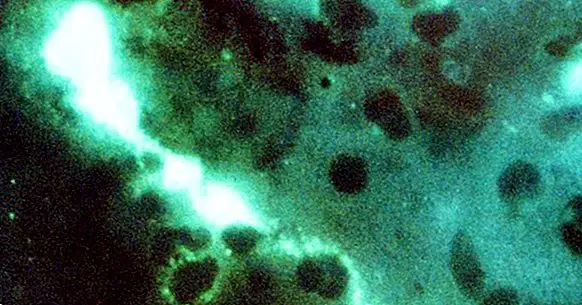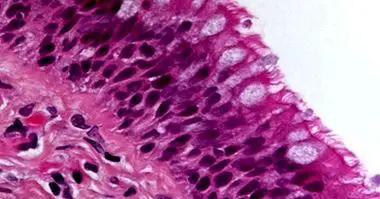Chlamydia: what it is, symptoms, causes and treatment of this STD
Sexually transmitted diseases or STDs they are a global pandemic that has affected the human being for centuries. The most known and worrying at present is HIV, which also has no known cure at the moment, but it is not the only STD that exists.
Gonorrhea or syphilis are also old known to mankind (the second has been responsible for the death of a large number of historical figures), although fortunately, despite being highly dangerous, they now have treatment.
But perhaps the most frequent sexually transmitted disease, and at the same time quite less known than the previous ones, is chlamydia . It is about this last one that we are going to talk about in this article.
- Related article: "Symptoms and signs of personality disorders"
Chlamydia: what is it?
Chlamydia or chlamydia is, as we have mentioned previously, a sexually transmitted disease (or sexually transmitted infection) caused by the infection generated by the bacterium Chlamydia trachomatis. It is the most common STD or STI, being present in a high percentage of the population and in many cases existing asymptomatically. Although it is considered a minor venereal disease by the majority of the population, the truth is that can have severe consequences for those who suffer it if they do not receive treatment .
This infection can occur in both men and women in the genitals (urethra or uterus), anus or throat depending on the route of infection. Young people are more at risk of contracting it, especially in the case of women, people with multiple sexual partners , that they do not use a condom or that they have previously presented another sexually transmitted infection.
It is a type of infection little discussed at social level, being frequent that infected people present symptoms (this being one of the reasons why it is more prevalent, since not noticing anything the infected continue spreading the disease).
Also, one aspect to keep in mind is that chlamydia usually occurs along with other sexually transmitted diseases, such as gonorrhea, and the fact that facilitates the risk that the person who suffers from contracting another STD , including HIV.
- Maybe you're interested: "HIV and AIDS: psychological effects of this disease"
Main symptoms and phases
One of the main problems of chlamydia is that in a high number of cases the infection is silent, not appearing notorious symptoms. However, this does not imply that the infection does not progress, and may generate the same health problems as the rest of the population if they are not treated.
In those subjects in whom chlamydia has symptoms, the symptoms differ slightly between men and women .
In the case of males, it is common for infection to appear in the urethra between one and three weeks after sexual contact, manifested through pain when urinating and the secretion of a milky substance (which may be whitish or transparent), especially from mornings These secretions can impregnate and stain underwear. There may be inflammation in the testicles and pain in the penis . If the sex has been anal or oral, the infection appears in these areas. In the eyes it can cause conjunctivitis.
In the case of women, it is not uncommon that there are alterations in the flow in terms of temporality, quantity or even coloration (yellowish). This flow can have a strong smell characteristic. Pain in intercourse or urination usually appears.
In summary, both men and women usually have pain or stinging at the time of urination or sexual intercourse, as well as ventral pain. It is not infrequent the presence of milky secretions in the penis of males or vaginal bleeding out of time or yellowish flow in the case of women. In the case of anal, oral or ocular infection it is not uncommon for pain, itching, secretions, bleeding or inflammation to appear in these areas. These infections can generate episodes of fever .
The contagion of this disease
Something very common in sexually transmitted diseases is the lack of knowledge on the part of the majority of the population regarding the transmission routes that exist. In the case of chlamydia, it is transmitted in most cases through sexual contact with an infected person, regardless of whether or not there is ejaculation .
The infection can occur when there is vaginal or anal penetration, as well as in oral penetration, without any type of barrier method (condom or other barrier methods). This last detail is important, since a large number of people are unaware of the risk of infection through this route.
In addition to this type of contact, contagion may also occur if semen or vaginal fluid comes in contact with other mucous membranes , like the eyes, when touched with hands impregnated with said fluids. Also, chlamydia is an infection that can become infected during delivery, in the case that the mother is infected.
Another type of contact, such as air or contact with saliva in the case of sneezing, kissing or drinking from the same glass does not allow the spread of this disease. It is also important to keep in mind that overcoming this disease does not provide immunity before it, with which new sexual contacts with infected people can generate a reinfection.
Consequences
Seen up to this point it may seem that chlamydia is not an excessively serious disease, but the truth is that it can have very relevant consequences for health and personal well-being, or it can even lead to death in some cases.
And it is that untreated chlamydia may end up generating pelvic inflammatory disease able to cause infertility, and can even degenerate into an ectopic pregnancy (in which the fertilized egg develops outside the uterus and usually in the fallopian tubes, something that could burst the area and could lead to death by internal bleeding) ) in the case of women.
In the case of transmission to a fetus during childbirth, chlamydia can lead to problems of eye infections and even pneumonia in the small child, or even the birth of underweight babies. As well greatly increases the possibility of abortion .
Treatment
One of the reasons why chlamydia is often undervalued is the fact that today has a curative treatment that can be applied with relative ease . However, this treatment will cure the chlamydial infection but not any other damage it has caused.
Mainly the treatment of chlamydia is based on the administration of antibiotics, there are different modalities (there is even a version of a single dose). The other great pillar that must be taken into account when eradicating this disease is prevention: it is necessary to use condoms or barrier methods when we have vaginal, anal or oral sex when we are not in a monogamous relationship or have multiple sexual partners.
Also, it is advisable to get tested once in a while if we are a risk population, if we are planning to conceive or if there is a pregnancy in progress. In case of infection, it is necessary to avoid maintaining relationships until the treatment is finished. The sexual partner (s) should also be treated even if they do not show symptoms. It is advisable to take the test about three months later of having finished it.
Bibliographic references:
- Braunwald, E .; Fauci, A.S .; Kasper, D.L .; Hauser, S.T .; Longo, D.L. & Jameson, J.L. (2001). Harrison's Principle of Internal Medicine.15th Edition. McGraw Hill.
- National Institute of Health (n.d.). Chlamydia infections MedlinePlus Available at: //medlineplus.gov/spanish/chlamydiainfections.html
- Workowski, K.A .; Bolan, G.A. (2015) Centers for Disease Control and Prevention. Sexually transmitted diseases treatment guidelines. MMWR Recomm Rep.; 64 (RR-03): 1-137



















